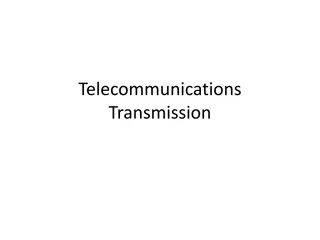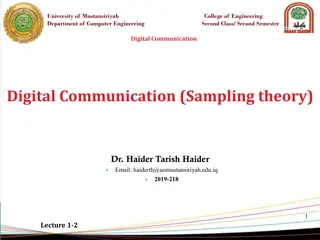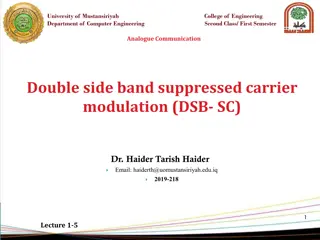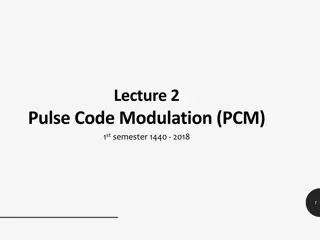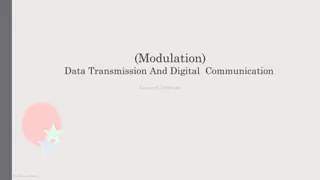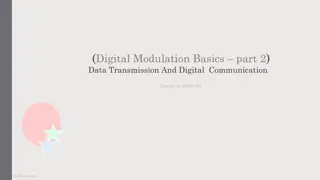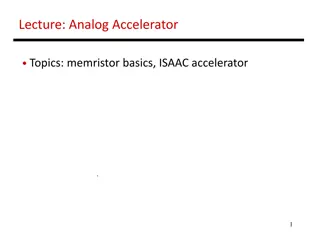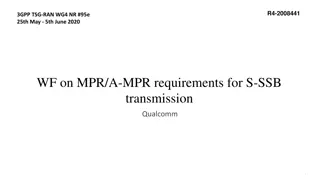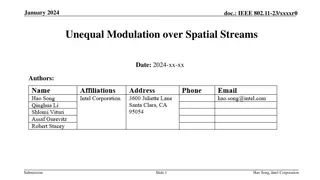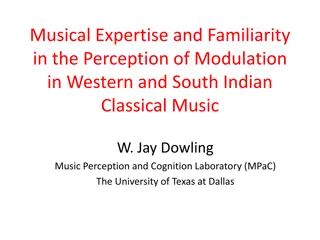Understanding SSB-SC Modulation in Analog Communication
Single Sideband Suppressed Carrier (SSB-SC) modulation is a technique in analog communication that transmits a single sideband along with the carrier signal, offering advantages such as reduced bandwidth consumption, increased signal transmission capacity, and lower noise interference. However, the generation and detection of SSB-SC waves can be complex, requiring frequency and phase discrimination methods. This modulation method provides efficient signal transmission with minimized noise and improved power utilization, although it requires precise frequency stability for optimal performance.
- Analog Communication
- SSB-SC Modulation
- Frequency Discrimination
- Phase Discrimination
- Signal Transmission
Download Presentation

Please find below an Image/Link to download the presentation.
The content on the website is provided AS IS for your information and personal use only. It may not be sold, licensed, or shared on other websites without obtaining consent from the author. Download presentation by click this link. If you encounter any issues during the download, it is possible that the publisher has removed the file from their server.
E N D
Presentation Transcript
Analog Communication SSB-SC Modulators Yogesh Patidar School of engineering and technology Dept. of Electronics Engineering vikram university ujjain
SSB-SC Modulation Sidebands along with the carrier and transmitting a single sideband is called as Single Sideband simply SSBSC. Advantages Bandwidth or spectrum space occupied is lesser than AM and DSBSC waves. Transmission of more number of signals is allowed. Power is saved. High power signal can be transmitted. Less amount of noise is present. Signal fading is less likely to occur. Disadvantages The generation and detection of SSBSC wave is a complex process. The quality of the signal gets affected unless the SSB transmitter and receiver have an excellent frequency stability. Suppressed Carrier system or
SSB-SC MODULATOR We can generate SSBSC wave using the following two methods. Frequency discrimination method Phase discrimination method
Frequency discrimination method In this method, first we will generate DSBSC wave with the help of the product modulator. Then, apply this DSBSC wave as an input of band pass filter. This band pass filter produces an output, which is SSBSC wave.
Block diagram of Frequency discrimination method
Phase Discrimination Method for SSB-SC The following figure shows the block diagram of SSBSC modulator using phase discrimination method.
Phase Discrimination Method The modulating signal Am cos(2 fmt) and the carrier signal Ac cos applied as inputs to the upper product modulator. So, the upper product modulator produces an output, which is the product of these two inputs. (2 fct) are directly s2(t)=AmAcCos (2 fmt 90)cos (2 fct 90) s2(t)=AmAcSin (2 fmt)sin (2 fct) [2 (fc fm)t] Cos [2 (fc+fm)t]} s2(t)=AmAc2{Cos Add s1(t) and s2(t) in order to get the SSBSC modulated wave s(t) having a lower sideband. [2 (fc+fm)t]+Cos [2 (fc fm)t] cos [2 (fc fm)t]}+ [2 (fc+fm)t]} s(t)=AmAc2{Cos AmAc2{Cos s(t)=AmAc{Cos [2 (fc fm)t]}
Phase Discrimination Method cont Subtract s2(t) from s1(t) in order to get the SSBSC modulated wave s(t) having a upper sideband. s(t)=AmAc2{cos AmAc2{cos s(t)=AmAccos Hence, by properly choosing the polarities of inputs at summer block, we will get SSBSC wave having a upper sideband or a lower sideband. [2 (fc+fm)t]+cos [2 (fc fm)t] cos [2 (fc+fm)t] [2 (fc fm)t]} [2 (fc+fm)t]}




